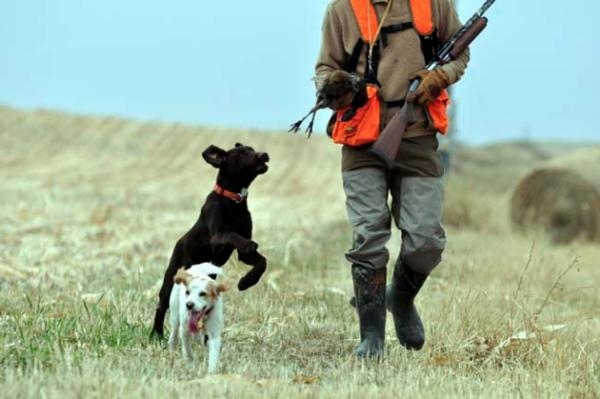Minnesota pheasant hunting season opens with a bang!

LAC QUI PARLE COUNTY, Minn. — No one yelled “rooster!” There was no need.
A few paces from the road, five pheasants flushed, a combination of males and females, in front of four hunters.
The blasting that ensued pre-empted any human vocalization. The first words uttered were from Gary Hauck: “Come on, guys! Let’s drop one!” A young rooster got past the volleys of Kailyn Helget — the first shots she had ever taken at a ring-necked pheasant. But the aim of her boyfriend, Anthony Hauck, was true, and the bird crash-landed in an adjacent field of corn stubble.
Toward it sprang Sprig, an 11-month-old English cocker, and Ace, a 4-month-old chocolate lab, both of whom now were on their first pheasant retrieves.
It was a flush of firsts, to be sure.
Now this is how the pheasant opener should be, I thought.
Last year witnessed one of the hardest pheasant hunting seasons in recent memory, the result of successive harsh winters and cold springs, and optimism abounded leading up to Saturday, Oct. 13, the first day of pheasant hunting in Minnesota. Some 50,000 were expected to take to the fields of central, west-central and southwest Minnesota, the birds’ core range.
Participating in the second-ever Governor’s Pheasant Opener, Gov. Mark Dayton hunted public land near Marshall on Saturday morning. He failed to see a rooster. But he appears to have bucked the trend.
Anecdotally, based on reports from Marshall-area landowners and scouts and the Haucks’ extended circle of hunter relatives and friends, there was little question there were more birds in the fields than last year. Statistically, that was indicated in data from an annual August count of pheasants, which yielded an index 68 percent above last year’s.
It was still well below the long-term average, though, and the preseason optimism doesn’t appear to have translated to an increase in sales of pheasant hunting licenses. As of Thursday, 42,488 stamps had been purchased, eight fewer than at the same time last year, according to the Minnesota Department of Natural Resources.
HABITAT TROUBLES
To be clear, the opening-day optimism was tempered throughout the pheasant hunting community — as well as the wider conservation and birding and bird-hunting communities — with the knowledge that the biggest factor in the long-term populations of a spectrum of prairie wildlife is falling.
That would be natural prairie habitat.
Commodities prices — notably corn and soybeans — have skyrocketed, increasing the value of the land at a speed that rapidly has outpaced federal payments to farmers to not farm land.
Roger Storlin, on whose land we hunted Saturday, knows it well.
“It’s tempting to sell because this land would sell for $8,000 an acre,” said Storlin, 78, who has been farming his 500 acres outside Madison for 57 years. Some 60 acres of his land is in some form of federally subsidized protection, such as the Conservation Reserve Program. With corn selling for more than $7 a bushel and Storlin’s fields surviving the drought well, the land could generate up to $1,400 per acre. Instead, he’s receiving $135 per acre from a CRP contract he signed 10 years ago.
He first quips that only his wife’s desire to keep the land protected has prevented him from selling.
“I started off poor as a church mouse,” Storlin said after the morning hunt as he stood by his farmhouse, peering through silos to his parcels that yielded four birds in the bag to our hunting party. “Farming has been good to me. I think I’m all right.”
In addition, the federal Farm Bill, which authorizes the bulk of such payments, is stalled in the U.S. House, trapped in a partisan debate as lawmakers struggle to find a balance between protecting grasslands and reducing government spending to tackle the federal deficit. The result is that on Sept. 30, Minnesota lost nearly 290,000 acres of CRP land that expired and can’t, at this point, be renewed. In the next three years, the state could lose more than 620,000 acres.
PUBLIC LANDS GROWING
Nobody has a credible plan, outside of federal subsidies, to counter that with any scale.
“The CRP dwarfs anything that we can do,” said Gary Hauck, president of the Lac Qui Parle County chapter of Pheasants Forever. “Over the next 10 years, we’ll be facing a changing landscape.”
Which isn’t to say nothing can be done.
Using state sales tax funds approved by voters in the 2008 Clean Water, Land and Legacy Amendment, Pheasants Forever has purchased thousands of acres of land — the group announced 1,820 acres in June — destined to become public hunting grounds. And the DNR, in conjunction with Pheasants Forever, Ducks Unlimited, the Audubon Society and others, this summer announced “The Minnesota Prairie Conservation Plan,” which aims to permanently protect grasslands by purchasing the land or easements from willing sellers.
Hauck, who is 60 and whose family can trace its roots to this land to about 100 years ago, says he can drive Lac Qui Parle County and quickly point out shallow wetlands and bordering prairies he hunted as a boy that now are drained and producing row crops.
At the same time, optimism couldn’t be suppressed Saturday.
“I can also tell you about days in the 1970s when we hunted all day and saw one hen,” he said. “Clearly, we’ve improved since then.”
For Helget, the 27-year-old first-timer from Roseville, the day was less about fretting over national policy and more about focusing on her budding hunting technique. Although her shots didn’t find feathers (nor did mine), by all accounts, she handled herself well, as did Sprig and Ace, the rookie dogs.
“Hunting is something I never thought I would do,” she said. “I took it up to spend time with this guy.” It was a reference to Anthony Hauck, her live-in boyfriend who works for White Bear Lake-based Pheasants Forever.
“I don’t feel much pressure yet to get a bird. It’s just a lot of fun.”
Dave Orrick can be reached at dorrick@pioneerpress.com.
Posted in: News

